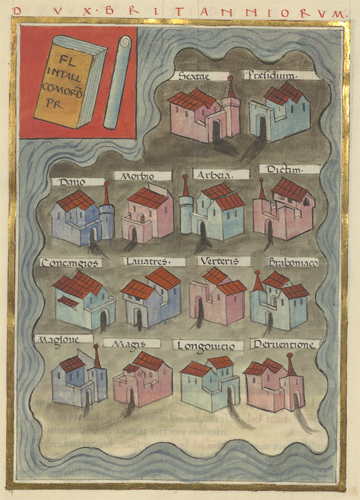
This page created 8 November 2015, and last modified: 1 December 2015 (Praetorio commentary revised)

The second officer listed (154.3 in Ingo Maier's numbering scheme) under the command of the Dux Britanniarum is the Praefectus equitum Dalmatarum, said to be stationed at Praesidio.
 Above: Notitia page 153 from the Parisian manuscript, P. The stations are labelled: Sextae, Presidium, Dano, Morbio, Arbeia, Dictim, Concangios, Lauatres, Verteris, Braboniaco, Magloue, Magis, Longouicio, Deruentione. These correspond to the 14 prefects under the Dux that are not stationed "along the line of the wall". |
The men under "the Prefect of the Dalmatian cavalry at Praesidio" are one of two Dalmatian cavalry units listed under British commanders according to the Notitia; the other (132.5), is under the Comes litoris Saxonici per Britanniam. Exactly what is meant by "Dalmatian" in the context of Roman cavalry is unclear, however.
The modern location of the station of the Dux' unit of equites Dalmatae, Praesidio (Praesidium in the frontspiece shown left), is unsure. It has been suggested that Praesidium refers not to a particular placename as such, but to the headquarters of the provincial governor ("Praeses"), which would be York (the name Praesidium is a common one, found in locations throughout the Roman empire). This raises the question of why two locations for York would be shown in the frontpiece (see the example to the left); one (153#2) bearing the caption (153.b) Sextae [sic], and the other (153#3) being labelled (153.c) Presidio (the Parisian manuscript almost always drops the "a" in any "ae" combination of letters). This is not in itself a fatal objction, however, as it is entirely possible for two units to be stationed at one locality; many other frontpieces in the Notitia show two (or even three) different illustrations of the same fort; e.g that of the Dux Provinciae Valeriae ripensis, where Intercisa is shown twice, together with a Nuncinercisa [sic]. A more serious objection, however, is that the ordering of entries 154.2-4 under the Dux implies a location of Praesidium between "Sextae" (York) and "Danum" (Doncaster); similarly, the British section of the Antonine Itinerary gives (Iter I) "Praetorio", and which is usually assumed to equate with Praesidium (as both words have the same meaning of, among other things, "headquarters"), as a place near to (and apparently beyond) York, as opposed to being York itself. Rivet and Smith opted for equating "Praetorio" / Praesidium with Brough-on-Humber (Petuaria), albeit very cautiously. This has its own problem, in that Petuaria would already seem to have been referenced in the Dux' command, as part of entry 154.15. Another possibility might be something like Bridlington on the North Sea coast; coastal erosion seems to have been heavy in the area, meaning any putative fort may have been destroyed by the sea. |
As with all limitanei units, the shield pattern of the Praesidian equites Dalmatae is not illustrated in the Notitia.
1. Ingo Maier; "Appendix 4: Numeration of the new edition of the compilation 'notitia dignitatum' (Cnd)"; last accessed 26 October 2015. See also for here for numbering examples. Return
2. A.L.F. Rivet & Colin Smith; "The Place-Names of Roman Britain"; Batsford, London, 1979; at p 442. Return
3. "Itinerarium provinciarum Antonini Augusti, Iter Britanniarum"; available here (last accessed 8 November 2015). Return
4. A.L.F. Rivet & Colin Smith; "The Place-Names of Roman Britain"; Batsford, London, 1979; at p 157. Return

Return to the Notitia alphabetical unit list page.
Return to my Notitia index page.